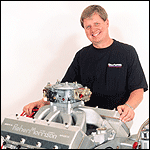 By David Reher, Reher-Morrison Racing Engines
By David Reher, Reher-Morrison Racing Engines
“The best racing engine is usually the one that has the best set of compromises.”
There is a widely held belief among racers and fans that a racing engine is a no-compromise design. Auto manufacturers must balance the conflicting demands of performance, fuel economy, emissions, long-term reliability, smoothness and cost when they design an engine for mass production. In racing, the requirements are pared down to the basics: power, reliability, legality, and affordability
A racing engine needs enough power to produce winning elapsed times, enough reliability to stay together through a race weekend, compliance with the rules to pass technical inspection, and a price that’s within the reach of potential purchasers. So in comparison to a street motor, a full-tilt racing engine appears to be a take-no-prisoners, no-compromise powerplant.
But it isn’t. A racing engine is a bundle of compromises. The best racing engine is usually the one that has the best set of compromises. That’s because there are virtually no components in a racing engine that can be changed without affecting the performance or reliability of other parts. They’re all connected in a web of interdependence.
For example, installing a cam with more lift and duration affects the pistons – not just the valve pocket depths, but probably the ring groove locations as well. A cylinder head port that looks great on the flow bench will be a disaster on the track if it requires valvetrain geometry that’s unstable at high rpm. Bolt on a big oil pan to reduce windage losses and then watch the oil pressure go to zero in the shutoff area. Lower the crankcase pressure with a vacuum pump to produce power and the wrist pins are now susceptible to wear and galling. Low viscosity oil helps an engine make more power; that’s good. But thin oil can make parts look marginal when the engine is torn down; that’s bad.
Building a powerful, reliable and cost-effective racing engine is about making the right choices on dozens – perhaps hundreds – of compromises. An established, experienced engine builder (and by this I don’t mean just Reher-Morrison Racing Engines) can make those decisions by drawing from a deep well of knowledge. Building a top-tier competition engine is much more than picking parts out of a catalog.
I’ve written before that these are the best of times for drag racers. The proliferation of aftermarket parts is unprecedented; engines that once were impossible to build now fill the staging lanes. But the downside of this explosion of choices is that the parts have become so specialized that they are seldom interchangeable.
When I got serious about racing in the early ’70s, we ran small-block Chevy V-8s with cast-iron cylinder heads. If I bought an intake manifold, a set of rocker arms or a header gasket, they fit a factory small-block casting. But today there is an astonishing variety of cylinder heads – each with specific valve locations, valve angles, port designs, bolt patterns and valvetrain requirements. Every head design requires specialized pistons, special valves, custom pushrods and unique rocker arms. Need an intake manifold for a new set of heads? The cylinder head manufacturer may not even produce a manifold – or it may be that another source has a vastly superior design. Selecting, modifying and assembling parts that are compatible is an engine builder’s biggest challenge today.
It takes a cooperative effort between premium engine builders and manufacturers to produce first-class parts. A manufacturer may see only one piece of the puzzle; the builder sees the whole picture. This two-way communication drives the continuous development of heads, pistons, cams, manifolds, valvetrain parts and other components.
With so many choices, it’s easy for inexperienced racers to lose control and end up with a pile of unusable parts. A good deal on a set of connecting rods is no bargain if they compromise the design of the pistons or require pounds of heavy metal to balance the crankshaft. A professional engine builder will work with a customer to avoid costly mistakes in parts selection – and that saves money in the long run.
There are some things in life that should never be compromised – honesty, integrity, and loyalty, for example. Unfortunately, a racing engine isn’t one of them.
